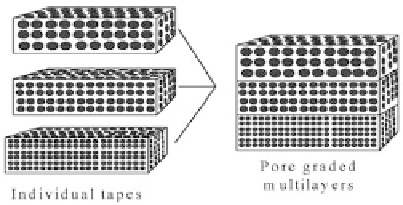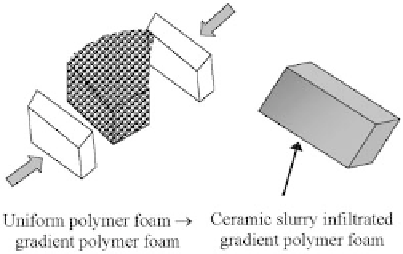Biomedical Engineering Reference
In-Depth Information
been fabricated [375, 411, 482, 484, 578-585, 588]. For example,
graded porous calcium orthophosphate bioceramics can be
produced by means of tape casting and lamination (Fig. 4.12a). Other
manufacturing techniques, such as a compression molding process
(Fig. 4.12b) followed by impregnation and firing, are known as well
[375]. In the first method, a HA slurry was mixed with a pore former.
The mixed slurry was then cast into a tape. Using the same method,
different tapes with different pore former sizes were prepared
individually. The different tape layers were then laminated together.
Firing was then done to remove the pore formers and sinter the HA
particle compacts, resulting in graded porous bioceramics [582]. This
method was also used to prepare graded porous HA with a dense part
(core or layer) in order to improve the mechanical strength, as dense
ceramics are much stronger than porous ceramics. However, as in
the pressure infiltration of mixed particles, this multiple tape casting
also has the problem of poor connectivity of pores, although the pore
size and the porosity are relatively easy to control. Furthermore,
the lamination step also introduces additional discontinuity of the
porosity on the interfaces between the stacked layers.
Figure 4.12
Schematic illustrations of fabrication of pore-graded
bioceramics: (a) lamination of individual tapes, manufactured
by tape casting; (b) a compression molding process. Reprinted
from Ref. [375] with permission.




Search WWH ::

Custom Search